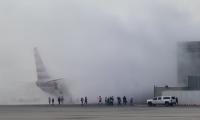Rawalpindi
Around 8.9 million people in Pakistan are drug addicts while 700 people die every day in the country due to drug–related complications making the deaths related to drugs greater than those caused by terrorism.
Most of the drugs come from Afghanistan, the country that is responsible for at least 75 per cent of the world’s heroin. More than three million Pakistanis between the ages of 15 and 64 use heroin regularly and there are almost five million cannabis users addicted to smoking high-grade hashish called ‘charas’. Globally, 1 in 20 adults, or 250 million people between the ages of 15 and 64 years are drug addicts.
Since the drugs are extremely cheap and easily accessible in the country, the abuse of cannabis and heroin is fairly high.
Head of Community Medicine at CMH Lahore Medical College Professor Dr Muhammad Ashraf Chaudhry expressed this while talking to ‘The News’ on Sunday in connection with the United Nations International Day against Drug Abuse and Illicit Trafficking that falls on June 26 each year to raise awareness of the major problem that illicit drugs represent to the society.
Each year the United Nation Office on Drugs and Crime (UNODC) selects theme for the day and this year the theme is “Listen First”. Listening to children and youth is the first step to help them grow healthy and safe. “Listen First” is an initiative to increase support for prevention of drug use that is based on science and is thus an affective investment in the well-being of children and youth, their families and their communities.
Professor Ashraf said the barriers preventing access to structured treatment are exceptionally high in Pakistan. An estimated 4.25 million individuals thought to be drug dependent in Pakistan are in dire need of professional treatment. However, the available structure has just 1990 beds available for drug treatment and can cater to less than 30,000 drug users a year. Anti-Narcotics Force has just four hospitals in the country to rehabilitate addicts, he said.
Talking of the reasons behind the increasing number of drug addicted people at alarming pace, he said the drug cartels in Pakistan are fully backed and supported by the powerful and the wealthy persons in the country. Moreover, apparently, police and drug mafia are colluding. Moreover, illicit drugs are easily, and cheaply available everywhere in Pakistan, he said.
It is important that drug trafficking once viewed largely as a social and criminal problem, has transformed in recent years into a major threat to the health and security of people and regions. The $61 billion annual market for Afghan opiates is funding insurgency, international terrorism and wider destabilization. Drug economy of the world is estimated to be $US 435billion.
According to Professor Ashraf, young people are more susceptible to drug use. Young people often talk about the “highs” but may not be aware of many “lows”. The widespread availability of drugs in Pakistan left the souls of the youth as lifeless as they could be, he said.
He explained that often drug abuse is linked to factors such as risk taking behaviours that may involve experimenting with narcotics, smoking and alcohol, social isolation, stress, anxiety, depression, peer pressure (bad company), modern life style, hippy culture, unemployment, excessive pocket money by parents and lack of supervision and attention, the desire for social acceptance, boredom, curiosity, just to feel good, weak religious belief and lot of free time at their disposal, easy access to drugs at low prices, existence and presence of drug dens, to heighten sexual pleasure, to overcome frustration/tragedies, use as pain medication and fashion.
He said it is generally observed that most of these drug addicts begin by seeking recreation from drugs that are highly addictive and lead to this anti-social habit. Eventually, the body starts to demand frequent use, until a time comes when the person can no longer function normally without the influence of such drugs, said Professor Ashraf.
He said research have proved that people who start smoking cigarettes and or drink alcohol at a young age are much more likely to experiment with illegal drugs than people who do not smoke or drink. Efforts should be made to control tobacco smoking in the country because it is the gateway to drug abuse, he said.
Drug use in general lead to a number of health problems, such as malnutrition, apathy, menstrual irregularities and irregular heart rhythm. There is economic breakdown of family, loss of self-confidence and will to work, loss of job, indulgence in crimes such as theft, and suicidal thoughts. Drug addicts are also more prone to accidents and are at higher risk of HIV/AIDS, hepatitis B & C, and tuberculosis, suicide, overdose deaths and cardiovascular diseases, said Professor Ashraf.
He added that married drug addicts have high probability of having mentally retarded and physically handicapped children. Young people who use cannabis are doubling their risk of psychotic symptoms like schizophrenia, hallucinations, hearing voices etc, he said.
He said parents can recognize their addict children by noting these symptoms: deep body emaciation, strong loss of appetite, difficulty in breathing and fatigue, strong nervous disturbance, long home absences, much money demand, telling lie to get money, isolation, remaining away from others, long sleeping time, laziness, pale face, tremors in fingers, constipation, irregularities in work and studies, no interest in everyday life, red eyes, slurred speech, circles under the eyes, neglect of personal hygiene and marks and traces of abusing on the body. The time parents see the above symptoms in their child, they should immediately contact the concerned addiction treatment unit for treatment of their child, he said.
He explained that treatment of drug addicts is done in three stages – assessment, detoxification and rehabilitation. The most difficult part of the treatment is rehabilitation in which there is a need to motivate a patient to take up a healthy activity preferably away from old places and old company. No one should be stigmatized against because of his dependence on drugs. Law enforcement agencies must treat drug users as victims rather than criminals. Drug dependence is a disease, not a crime. The real criminals are the drug traffickers, he said.
He added that awareness campaigns through mass media, essay contests, lectures and declamation contests in schools, colleges and universities should be run in order to create awareness about the ill effects of drug addiction. Provincial education departments should develop a curriculum against drugs for inclusion in textbooks at school, college and university levels. Public awareness campaigns are needed to be run every day on television and radio. All television channels should devote 0.5% of air time to raise awareness on the devastations of drug addiction. More recreational facilities should be created to take the youth off the drugs, he said.
Moreover, there is a dire need to increase treatment facilities for drug addicts in the public sector because treatment is very costly in private sector centres, concluded Professor Ashraf.
Pharmacy Council of Pakistan building can be seen in this image. — pcpisb.gov.pk/FileIslamabad:The Pharmacy...
Federal Minister for Communications Abdul Aleem Khan presiding over a high-level National Highway Authority meeting...
A representational image of a police tape restricting an incident scene. — Reuters/FileIslamabad:In a tragic...
Federal Minister for Information Technology and Telecommunications Shaza Fatima Khawaja exchanging views with Khazar...
Federal Minister for Parliamentary Affairs Dr Tariq Fazal Chaudhry addresses an event on February 2, 2025. —...
This representational image shows teachers staging a protest rally and boycotting classes. — Facebook@Punjab...







